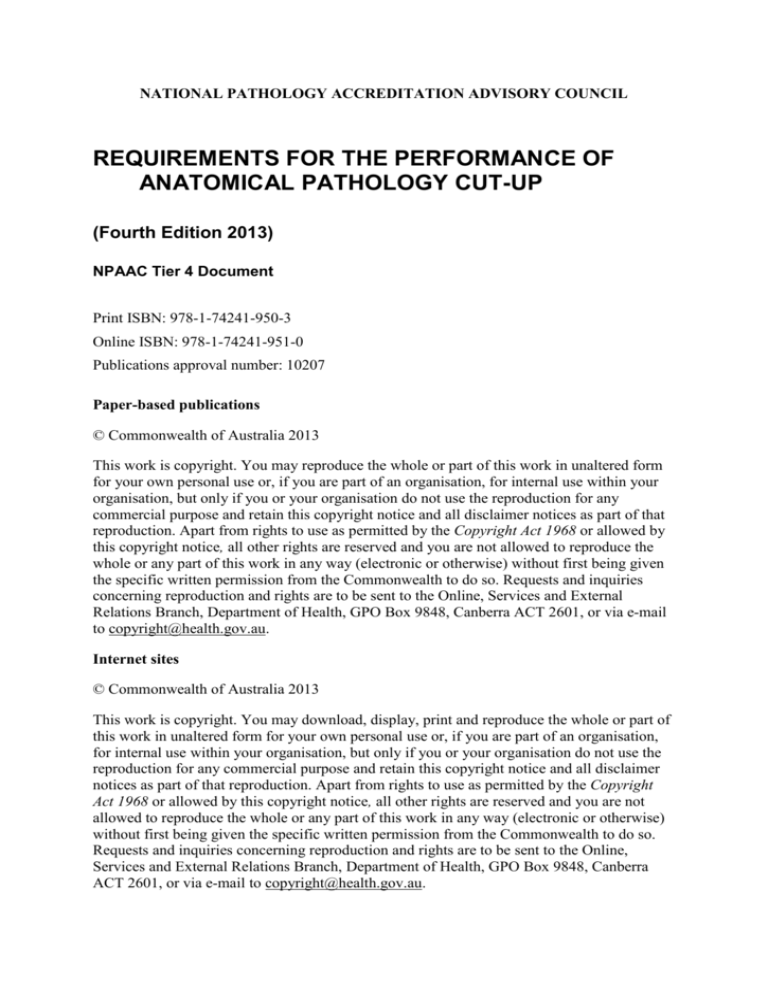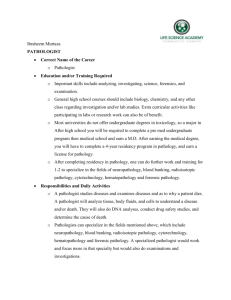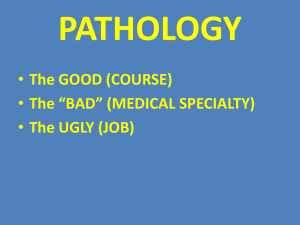
NATIONAL PATHOLOGY ACCREDITATION ADVISORY COUNCIL
REQUIREMENTS FOR THE PERFORMANCE OF
ANATOMICAL PATHOLOGY CUT-UP
(Fourth Edition 2013)
NPAAC Tier 4 Document
Print ISBN: 978-1-74241-950-3
Online ISBN: 978-1-74241-951-0
Publications approval number: 10207
Paper-based publications
© Commonwealth of Australia 2013
This work is copyright. You may reproduce the whole or part of this work in unaltered form
for your own personal use or, if you are part of an organisation, for internal use within your
organisation, but only if you or your organisation do not use the reproduction for any
commercial purpose and retain this copyright notice and all disclaimer notices as part of that
reproduction. Apart from rights to use as permitted by the Copyright Act 1968 or allowed by
this copyright notice, all other rights are reserved and you are not allowed to reproduce the
whole or any part of this work in any way (electronic or otherwise) without first being given
the specific written permission from the Commonwealth to do so. Requests and inquiries
concerning reproduction and rights are to be sent to the Online, Services and External
Relations Branch, Department of Health, GPO Box 9848, Canberra ACT 2601, or via e-mail
to copyright@health.gov.au.
Internet sites
© Commonwealth of Australia 2013
This work is copyright. You may download, display, print and reproduce the whole or part of
this work in unaltered form for your own personal use or, if you are part of an organisation,
for internal use within your organisation, but only if you or your organisation do not use the
reproduction for any commercial purpose and retain this copyright notice and all disclaimer
notices as part of that reproduction. Apart from rights to use as permitted by the Copyright
Act 1968 or allowed by this copyright notice, all other rights are reserved and you are not
allowed to reproduce the whole or any part of this work in any way (electronic or otherwise)
without first being given the specific written permission from the Commonwealth to do so.
Requests and inquiries concerning reproduction and rights are to be sent to the Online,
Services and External Relations Branch, Department of Health, GPO Box 9848, Canberra
ACT 2601, or via e-mail to copyright@health.gov.au.
First published 2001
Second edition 2006
Third edition 2012
(formerly titled: Guidelines for the Performance of Pathology
Surgical Cut-Up)
Fourth edition 2013
reprinted and reformatted to be read in conjunction with the
Requirements for Medical Pathology Services
Australian Government Department of Health
Contents
Scope..........................................................................................................................................3
Abbreviations ...........................................................................................................................3
Definitions .................................................................................................................................3
Introduction ..............................................................................................................................1
1.
Persons performing the Cut-up ..................................................................................7
Specimen types and level of autonomy .........................................................................7
Persons permitted to perform Cut-up .............................................................................7
Savings provision .....................................................................................................................7
2.
Competence and Training ...........................................................................................8
Verification of Competence ...........................................................................................8
Ongoing Competence.....................................................................................................8
Training ..........................................................................................................................8
3.
Cut-up Manual .............................................................................................................9
Appendix A Specimen Category Allocation (Informative) .................................................9
Simple Specimens (fixed for direct transfer) .....................................................9
Non-complex Specimens (fixed) ......................................................................10
Complex Specimens .........................................................................................11
Additional Reading ................................................................................................................12
Further Information ..............................................................................................................11
The National Pathology Accreditation Advisory Council (NPAAC) was established in 1979
to consider and make recommendations to the Australian, state and territory governments on
matters related to the accreditation of pathology laboratories and the introduction and
maintenance of uniform standards of practice in pathology laboratories throughout Australia.
A function of NPAAC is to formulate Standards and initiate and promote education programs
about pathology tests.
Publications produced by NPAAC are issued as accreditation material to provide guidance to
laboratories and accrediting agencies about minimum Standards considered acceptable for
good laboratory practice.
Failure to meet these minimum Standards may pose a risk to public health and patient safety.
Scope
The Requirements for the Performance of Anatomical Pathology Cut-Up is a Tier 4 NPAAC
document and must be read in conjunction with the Tier 2 document Requirements for
Medical Pathology Services. The latter is the overarching document broadly outlining
standards for good medical pathology practice where the primary consideration is patient
welfare, and where the needs and expectations of patients, Laboratory staff and referrers
(both for pathology requests and inter-Laboratory referrals) are safely and satisfactorily met
in a timely manner.
Whilst there must be adherence to all the Requirements in the Tier 2 document, reference to
specific Standards in that document are provided for assistance under the headings in this
document.
The Requirements for the Performance of Anatomical Pathology Cut-Up sets out the
standards for the training and performance of the anatomical pathology Cut-up.
Abbreviations
AS
ISO
NATA
NPAAC
RCPA
Australian Standard
International Organization for Standardization
National Association of Testing Authorities
National Pathology Accreditation Advisory Council
Royal College of Pathologists of Australasia
Definitions
Attested
means to affirm, certify or confirm documented evidence.
Cut-up (or ‘grossing’)
means the transfer, or selection, or cutting and orientating, or
combinations of all three, of individually identified Specimens,
and the placement of these tissues in identified cassettes for
further processing, and the recording of the number and
Macroscopic description of the tissues submitted for further
processing.
Cut-up under
supervision
means the Cut-up is performed with the Pathologist or Trained
Delegate physically present and observing the performance of the
Cut-up. Telepathology is not acceptable as a tool of supervision.
Macroscopic
description
means the description of the physical characteristics of a
Specimen, which may be augmented by diagrams, photography or
x-rays.
Medical Practitioner
means the same as that given by subsection 3(1) of the Health
Insurance Act 1973.
Pathologist
means the same as the definition in the NPAAC Requirements for
the Supervision of Pathology Laboratories.
For the purposes of this document a Pathologist refers to one
whose scope of practice includes Anatomical Pathology.
Pathology Trainee
means a person who is enrolled in a training program in pathology
as defined by the Royal College of Pathologists of Australasia.
Requirements for
Medical Pathology
Services (RMPS)
means the overarching document broadly outlining standards for
good medical pathology practice where the primary consideration
is patient welfare, and where the needs and expectations of
patients, Laboratory staff and referrers (both for pathology
requests and inter-Laboratory referrals) are safely and
satisfactorily met in a timely manner.
The standard headings are set out below –
Standard 1 – Ethical Practice
Standard 2 – Governance
Standard 3 – Quality Management
Standard 4 – Personnel
Standard 5 – Facilities and Equipment
A – Premises
B – Equipment
Standard 6 – Request-Test-Report Cycle
A – Pre-Analytical
B – Analytical
C – Post-Analytical
Standard 7 – Quality Assurance
Scientist
means the same as the definition in the NPAAC Requirements for
the Supervision of Pathology Laboratories.
Specimen categories
simple Specimens—small biopsy Specimens, which are
transferred directly from fixative to cassettes for subsequent
processing without any selection or dissection taking place.
non-complex Specimens—Specimens that require some
interpretation.
complex Specimens—Specimens that require detailed
interpretation based on appropriate training and experience.
Refer to Appendix A for Specimens in each category.
Student
means –
(a) a person accepted into a medical school and enrolled in an
educational program in medicine as defined by the Australian
Medical Council, or
(b) a person enrolled in a post-secondary program (tertiary or
vocational) in the discipline of pathology or laboratory
medicine.
Technical Officer
means the same as the definition in the NPAAC Requirements for
the Supervision of Pathology Laboratories.
Trained Delegate
means a person who is not a Pathologist but has been Attested by a
Pathologist as competent to perform any or all of the specified
task/s relating to Cut-up:
Triaging
Receiving the Specimen for Cut-up
Allocating the Specimen for Cut-up
Performing the Cut-up
Training others to perform these tasks.
means sorting according to priority and subsequent Specimen
handling and allocation.
Introduction
Most anatomical pathology Laboratories receive a wide range of Specimens, some of which
can be processed in total as received while others have to be Cut-up before subsequent
processing. The principle of the Cut-up is the presentation of the whole or a representative
portion of a Specimen for processing into histological sections that enable a diagnosis or a
Pathologist opinion to be rendered. The Cut-up can be performed by persons other than
Pathologists, without compromising safety or standards provided such persons have the
required training and supervision and work within the framework of appropriate protocols.
The Pathologist has the ultimate responsibility for the handling of a Specimen regardless of
who has performed the Cut-up.
These Requirements are intended to serve as minimum standards in the accreditation process
and have been developed with reference to current and proposed Australian regulations and
other standards from the International Organization for Standardization including:
AS ISO 15189 Medical laboratories – Requirements for quality and competence
These Requirements should be read within the national pathology accreditation framework in
conjunction with the current version of each of the following NPAAC documents:
Tier 2 Document
Requirements for Medical Pathology Services
All Tier 3 Documents
In addition to these Standards, Laboratories must comply with all relevant state and territory
legislation (including any reporting requirements).
In each section of this document, points deemed important for practice are identified as either
‘Standards’ or ‘Commentaries’.
A Standard is the minimum requirement for a procedure, method, staffing resource or
facility that is required before a Laboratory can attain accreditation – Standards are
printed in bold type and prefaced with an ‘S’ (e.g. S2.2). The use of the word ‘must’
in each Standard within this document indicates a mandatory requirement for
pathology practice.
Commentaries are prefaced with a ‘C’ (e.g. C1.2) and are placed where they add the
most value. Commentaries may be normative or informative depending on both the
content and the context of whether they are associated with a Standard or not. Note
that when comments are expanding on a Standard or referring to other legislation,
they assume the same status and importance as the Standards to which they are
attached. Where a Commentary contains the word ‘must’ then that commentary is
considered to be normative.
Please note that the Appendix attached to this document is informative and should be
considered to be an integral part of this document.
All NPAAC documents can be accessed at NPAAC Website
While this document is for use in the accreditation process, comments from users would be
appreciated and can be directed to:
The Secretary
NPAAC Secretariat
Department of Health
GPO Box 9848 (MDP 951)
CANBERRA ACT 2601
Phone:
+61 2 6289 4017
Fax:
+61 2 6289 4028
Email:
NPAAC Email Address
Website:
NPAAC Website
Persons performing the Cut-up
(Refer to Standard 4 in Requirements for Medical Pathology Services)
The Pathologist has the ultimate responsibility for the handling of a Specimen regardless of
who has performed the Cut-up. The Triaging, Cut-up and training can be delegated by the
Pathologist to persons other than Pathologists.
The Cut-up process involves dealing with a range of Specimen types requiring personnel who
are Attested to be competent in performing those specified tasks.
At any time, if the person performing any part of the Cut-up is uncertain about their
competency to handle any Specimen, then that Specimen must be referred to a Pathologist or
Trained Delegate.
Specimen types and level of autonomy
S1.1
The person Triaging the Specimen for Cut-up must be a Pathologist or a Trained
Delegate.
C1.1
S1.2
The categories in Appendix A provide guidance as to the level of Specimen
complexity.
The Pathologist or Trained Delegate must allocate Specimens to persons Attested
as competent to Cut-up those Specimens.
Persons permitted to perform Cut-up
S1.3
In addition to Pathologists, persons performing the Cut-up, subject to attestation
of competency relevant to the level of Specimen complexity, must be one of the
following:
(a)
Pathology Trainees
(b)
Medical Practitioners other than those in (a)
(c)
Scientists
(d)
Technical Officers
(e)
Students, as defined for the purpose of this document
(f)
a person who is covered by S1.4.
Savings provision
This provision sets out those persons who may provide Cut-up though they are not a person
referred to in S1.3 (a) to (e). These persons have been providing Cut-up prior to the
commencement of these Requirements.
S1.4
A person who:
(a)
(b)
immediately prior to the commencement of these Requirements:
(i)
is not a Technical Officer, Scientist, Medical Practitioner,
Pathology Trainee or Pathologist; and
(ii)
provides documentary evidence of at least 3 years’ experience in
performing Cut-up; and
has performed Cut-up in a NATA/RCPA accredited Laboratory, or
equivalent, in the 12 month period prior to the date of commencement of
these Requirements;
must, at the commencement of these Requirements, be Attested by the
Pathologist as being competent to continue to perform Cut-up.
2.
Competence and Training
(Refer to Standard 4 in Requirements for Medical Pathology Services)
Verification of Competence
S2.1
The Pathologist must attest to the competence of the Trained Delegate
performing any or all of their specified task/s relating to Cut-up.
Ongoing Competence
S2.2
The Pathologist must re-assess and record competence of the Trained Delegate
performing any or all of their specified task/s relating to Cut-up. This must be
performed at least annually.
C2.2
To support this assessment process, the Laboratory should establish and foster
a process of continuous quality improvement of Cut-up through dynamic
review and feedback. This includes immediate feedback on performance.
Training
Generally the acquisition of competence should progress from simple to non-complex to
complex Specimen categories.
S2.3
Those not Attested as being competent at any task relating to Cut-up that they
are required to perform must undergo training.
S2.4
In addition to Pathologists, persons who can provide training must be one of the
following:
(a)
Pathology Trainees
(b)
Medical Practitioners, other than those in (a)
(c)
Scientists
(d)
Technical Officers.
S2.5
Those trainers listed in S2.4 (a) to (d) must be Attested as competent to perform
the task relating to the Cut-up for which they are providing training.
S2.6
Training programs must include study of the Laboratory Cut-up manual and
must progress through the following stages:
(a)
observations of Cut-up being performed by the trainer or supervisor
(b)
hands-on Cut-up under supervision
(c)
verification of competence for the levels of complexity
(d)
unsupervised practice with documented feedback from Pathologists and
other Laboratory staff.
3.
Cut-up Manual
(Refer to Standard 3 in Requirements for Medical Pathology Services)
S3.1
Each Laboratory must have a Cut-up manual. *
C3.1
This Cut-up manual should include:
(i)
up
a brief summary of the various clinical settings necessary to assist Cut-
(ii)
a list of minimum data to be included in the description of a Specimen
including tissue block key identification
(iii)
illustrations and diagrams showing the Cut-up approach and the
method of block selection to be used where applicable
(iv)
a note of the clinical information to be recorded for Specimens where
applicable
(v)
a reference to all relevant components for the handling of cancer
Specimens as provided in the RCPA Structured Reporting for Cancer
protocols.
Appendix A
Specimen Category Allocation (Informative)
Simple Specimens (fixed for direct transfer)
Specimens from the following sites, which are transferred in their entirety directly from
fixative into cassettes for subsequent processing without any orientation, selection or
dissection taking place:
Anus
*
Small bowel
Refer to: Examples are listed in Additional Reading on page 11
Bone marrow (trephine)
Brain
Breast
Bronchus
Ear – middle/inner
Stomach
Testis
Tongue
Trachea
Ureter
Heart
Large bowel
transurethral resection (TURB)
Larynx
Liver
Lung
Naso/Oropharynx/Sinus
Oral mucosa
Urethra
Urinary bladder including the entirety of a
Uterine cervix
Uterus dilation and curettage (D&C)
Vagina
Vulva
Oesophagus
Pancreas
Peritoneum
Pleura/Pericardium
Prostate – needle core biopsies or the entirety of a transurethral resection of prostate (TURP)
Non-complex Specimens (fixed)
Specimens that require some interpretation and are part or all of the following structures and
are of a size exceeding that of simple Specimens for direct transfer:
Appendix
Odontogenic cyst
Artery
Omentum
Bartholins gland cyst
Ovary, not neoplasm
Bone – bone banking, suture, curetting
Parathyroid
Breast reduction
Products of conception
Cholesteatoma
Prostate – transurethral resection (TURP) if
only part of the Specimen is selected for processing
Digits, amputation
Salivary gland – Mucocoele
Eye, conjunctiva biopsy
Skin, local resection/punch
Eye, cornea
Miscellaneous tissue – abscess/haematoma,
sinus, thrombus, varicosity
Fallopian tube
Soft tissue biopsy
Foreskin
Soft tissue – subcutaneous fatty tissue lesions
only
Gallbladder
Teeth
Ganglion cyst
Tendon biopsy or mass
Hair
Testis, castration
Heart valve
Tonsil/Adenoid
Hernia sac
Ureter resection
Hydrocoele sac
Urethra resection
Joint biopsy
Urinary bladder – trans urethral resection if only
part of the Specimen is selected for processing
Kidney core
Large bowel polypectomy
Lip biopsy or wedge
Liver cyst/trauma
Lymph node - core
Uterine cervix LLETZ/Cone
Uterine polyp
Vasectomy
Nail
Naso/Oropharynx/Sinus polyp
Nerve
Complex Specimens
Specimens that require detailed interpretation based on training and experience and that are
part or all of:
Adrenal
Pancreas, cyst/neoplasm
Anal resection
Penisectomy
Bile duct resection
Pituitary neoplasm
Bone (all others)
Placenta
Brain (all others)
Prostate (all others)
Breast (all others including implants)
Retroperitoneal mass
Carotid body neoplasm
Salivary gland neoplasm (+/- neck)
Explant – transplant (e.g. heart, lung, kidney, liver) Skin with regional nodes
Extremity amputation (all)
Small bowel (all others)
Eye, enucleation
Stomach (all others)
Gallbladder with liver resection
Spleen
Jaw resection
Soft tissue neoplasms (other than
subcutaneous fatty tissue lesions)
Kidney (all others)
Testis (all others)
Kidney core (not fixed)
Thymus
Large bowel resection (all others)
Thyroid
Liver tumour
Tongue/Tonsil tumour
Lung (all others)
Urinary bladder-cystectomy
Lymph node (all others)
Uterus (all others) +/- adnexa
Mediastinum mass
Vagina, resection
Morcellated Specimens
Vulva, resection
Muscle biopsy
All Specimens in fluids other than fixatives
e.g. cell block
Naso/Oropharynx resection
Fresh Specimens (all other) – where ancillary
tests need to be performed or research sampling is undertaken
Odontogenic neoplasm/jaw
ALL SPECIMENS NOT OTHERWISE
LISTED
Oesophagus (all others)
Ovary neoplasm
Additional Reading
1.
Lester SC. Manual of Surgical Pathology. 3rd edition. Philadelphia: Mosby Elsevier,
2010.
2.
Rosai J. Rosai and Ackerman’s Surgical Pathology. 9th edition. Edinburgh: Mosby,
2004.
3.
Westra WH, Hruban RH, Phelps TH, Isacson C. Surgical Pathology Dissection. 2nd
edition, New York: Springer, 2002.
4.
The Royal College of Pathologists of Australasia <RCPA Website>
Further information
Other NPAAC documents are available from:
The Secretary
NPAAC Secretariat
Department of Health
GPO Box 9848 (MDP 951)
CANBERRA ACT 2601
Phone:
+61 2 6289 4017
Fax:
+61 2 6289 4028
Email:
NPAAC Email Address
Website:
NPAAC Website







